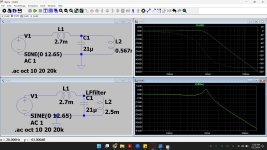Hi folks!
I am fooling around with Altec speakers, and trying to run the 808 8a + 511b horns with 416a / b style woofers. At the present time I do not have any questions regarding the HPF and horn correction circuit; I am hoping for some basic design input in the spirit of "look this direction".
At the encouragement of an engineer friend, I am learning to use LTspice. The following screenshot shows the Z19 / Altec Model 19 LPF. Top models use TS parameters associated with the 416Z (0.567 mH VC inductance / 11.6ohm series resistance) -- bottom models use the 416B (2.5mH / 6.5ohm series resistance).
In both screenshots, the bottom model represents the LPF circuit with the intended 8 ohm woofer. My intent is to create a model for a 16 ohm woofer which corresponds to the frequency filter response with the 8 ohm woofer.
First model, with matching crossover values:



With matching XO values, I get:
Top: 416 Z (16 ohm nominal): -6db @ 1.130 kHz
Bottom: 416 B (8 ohm nominal): -6db @ 1.330 kHz
With capacitor value doubled and inductor halved for the 16 ohm nominal speaker, I get this:

Top: 416 Z (16 ohm nominal): -6db @ 1.180 kHz
Bottom: 416 B (8 ohm nominal): -6db @ 1.330 kHz (unchanged)
I realize that I am a newbie and generally speaker crossovers are regarded as EXTREMELY complex, so I am not looking for a silver bullet. Does anyone have some math or anecdotal suggestions? What could I try next?
EDIT to add: I realize I am only using two parameters to define an inductor and there must be significantly more sophisticated ways to do this, and I'm learning as I go!
I am fooling around with Altec speakers, and trying to run the 808 8a + 511b horns with 416a / b style woofers. At the present time I do not have any questions regarding the HPF and horn correction circuit; I am hoping for some basic design input in the spirit of "look this direction".
At the encouragement of an engineer friend, I am learning to use LTspice. The following screenshot shows the Z19 / Altec Model 19 LPF. Top models use TS parameters associated with the 416Z (0.567 mH VC inductance / 11.6ohm series resistance) -- bottom models use the 416B (2.5mH / 6.5ohm series resistance).
In both screenshots, the bottom model represents the LPF circuit with the intended 8 ohm woofer. My intent is to create a model for a 16 ohm woofer which corresponds to the frequency filter response with the 8 ohm woofer.
First model, with matching crossover values:


With matching XO values, I get:
Top: 416 Z (16 ohm nominal): -6db @ 1.130 kHz
Bottom: 416 B (8 ohm nominal): -6db @ 1.330 kHz
With capacitor value doubled and inductor halved for the 16 ohm nominal speaker, I get this:
Top: 416 Z (16 ohm nominal): -6db @ 1.180 kHz
Bottom: 416 B (8 ohm nominal): -6db @ 1.330 kHz (unchanged)
I realize that I am a newbie and generally speaker crossovers are regarded as EXTREMELY complex, so I am not looking for a silver bullet. Does anyone have some math or anecdotal suggestions? What could I try next?
EDIT to add: I realize I am only using two parameters to define an inductor and there must be significantly more sophisticated ways to do this, and I'm learning as I go!
Last edited:
If you have a DATs system, then run it on both of your 416Z woofers and derive their ( raw > out-of-box ) TS parameters.
Before you go too far down this rabbit hole, you need to know that your woofers are up to ( or close to ) their original spec. > it's the top octaves that suffer if they are out and partially demagged .
In particular one is looking for a very low Qes figure ( which along with the Qts product and the Fs ) will really help determine the health of the magnetic drive system of those woofers.
Once obtained, one can compare your EBP numbers to the ( known ) numbers of the 416b model. The 416z(a) should be a smidge higher ( historically ).
If you don't have DATs, then I recommend that you buy it ( from P.E. ) or borrow someones.
🙂
PS: You'd be much further ahead ( when it comes to speakers ) if you learn BoxSim or Xsim or VituixCad2 ( rather than a LTSpice )
Before you go too far down this rabbit hole, you need to know that your woofers are up to ( or close to ) their original spec. > it's the top octaves that suffer if they are out and partially demagged .
In particular one is looking for a very low Qes figure ( which along with the Qts product and the Fs ) will really help determine the health of the magnetic drive system of those woofers.
Once obtained, one can compare your EBP numbers to the ( known ) numbers of the 416b model. The 416z(a) should be a smidge higher ( historically ).
If you don't have DATs, then I recommend that you buy it ( from P.E. ) or borrow someones.
🙂
PS: You'd be much further ahead ( when it comes to speakers ) if you learn BoxSim or Xsim or VituixCad2 ( rather than a LTSpice )
Hi Earl,
Thank you, much appreciated. I will order the dayton DATS device and download VituixCad. I'll report back when I have something to show.
Thank you, much appreciated. I will order the dayton DATS device and download VituixCad. I'll report back when I have something to show.